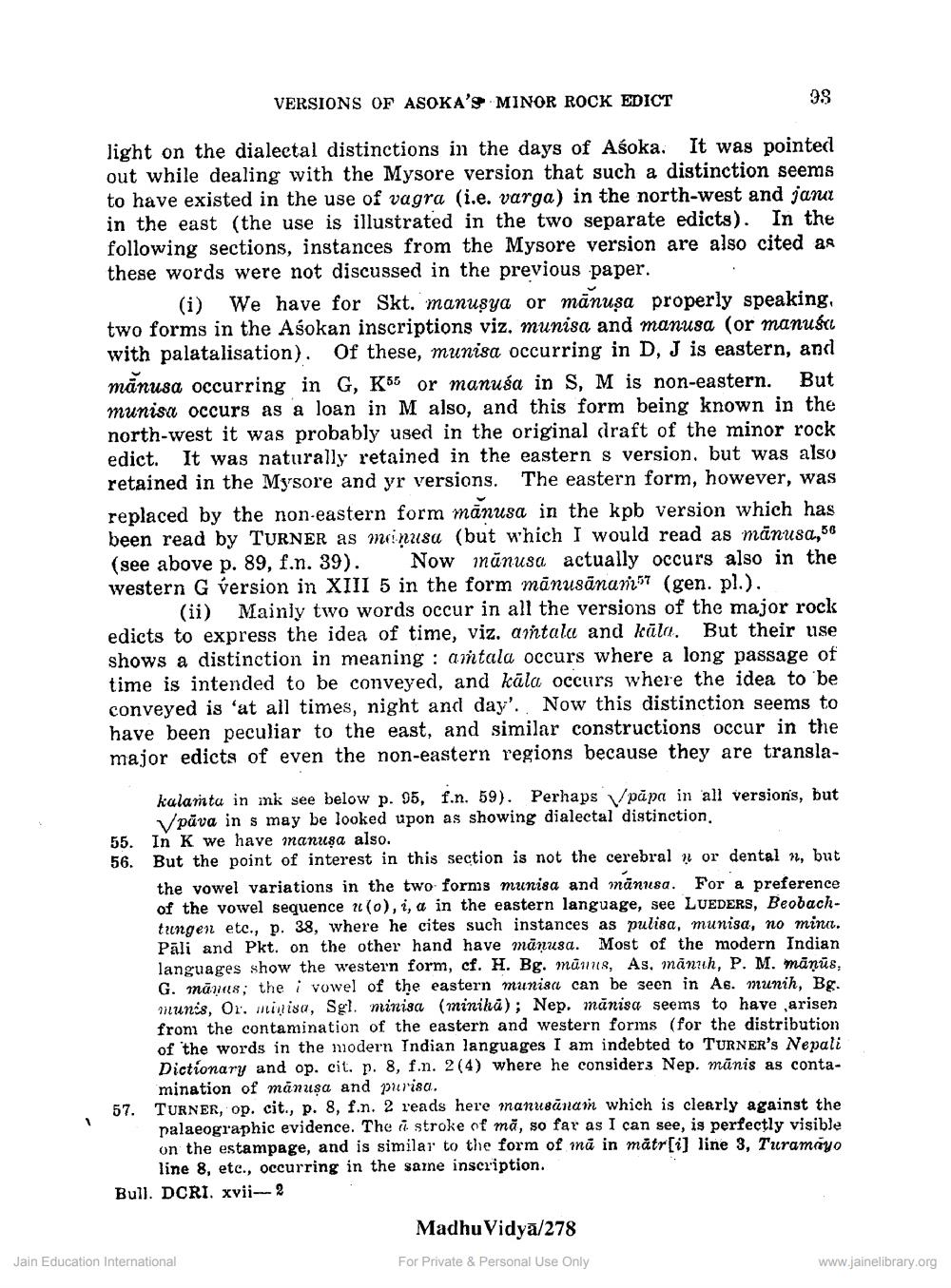________________
VERSIONS OF ASOKA'S MINOR ROCK EDICT
light on the dialectal distinctions in the days of Aśoka. It was pointed out while dealing with the Mysore version that such a distinction seems to have existed in the use of vagra (i.e. varga) in the north-west and jana in the east (the use is illustrated in the two separate edicts). In the following sections, instances from the Mysore version are also cited as these words were not discussed in the previous paper.
38
(i) We have for Skt. manusya or manusa properly speaking. two forms in the Aśokan inscriptions viz, munisa and manusa (or manufa with palatalisation). Of these, munisa occurring in D, J is eastern, and manusa occurring in G, K or manusa in S, M is non-eastern. But munisa occurs as a loan in M also, and this form being known in the north-west it was probably used in the original draft of the minor rock. edict. It was naturally retained in the eastern s version. but was also retained in the Mysore and yr versions. The eastern form, however, was replaced by the non-eastern form manusa in the kpb version which has been read by TURNER as menusu (but which I would read as manusa,58 (see above p. 89, f.n. 39). Now manusa actually occurs also in the western G version in XIII 5 in the form manusānam (gen. pl.).
(ii) Mainly two words occur in all the versions of the major rock edicts to express the idea of time, viz. amtala and kala. But their use shows a distinction in meaning: amtala occurs where a long passage of time is intended to be conveyed, and kala occurs where the idea to be conveyed is 'at all times, night and day'. Now this distinction seems to have been peculiar to the east, and similar constructions occur in the major edicts of even the non-eastern regions because they are transla
kalamta in mk see below p. 95, f.n. 59). Perhaps papa in all versions, but Vpava in s may be looked upon as showing dialectal distinction.
55. In K we have manusa also.
56. But the point of interest in this section is not the cerebral or dental n, but
the vowel variations in the two forms munisa and manusa. For a preference of the vowel sequence (o), i, a in the eastern language, see LUEDERS, Beobachtungen etc., p. 38, where he cites such instances as pulisa, munisa, no mina. Pāli and Pkt. on the other hand have manusa. Most of the modern Indian languages show the western form, cf. H. Bg. manus, As, manuh, P. M. mānūs, G. manus; the i vowel of the eastern munisa can be seen in As. munih, Bg. munis, Or. minisa, Sgl. minisa (miniha); Nep. manisa seems to have arisen from the contamination of the eastern and western forms (for the distribution of the words in the modern Indian languages I am indebted to TURNER'S Nepali Dictionary and op. cit. p. 8, f.n. 2(4) where he considers Nep. manis as contamination of manusa and purisa.
57. TURNER, op. cit., p. 8, f.n. 2 reads here manusanam which is clearly against the palaeographic evidence. The a stroke of mã, so far as I can see, is perfectly visible on the estampage, and is similar to the form of ma in matr[i] line 3, Turamayo line 8, etc., occurring in the same inscription.
Bull. DCRI. xvii-2
Jain Education International
Madhu Vidya/278
For Private & Personal Use Only
www.jainelibrary.org




